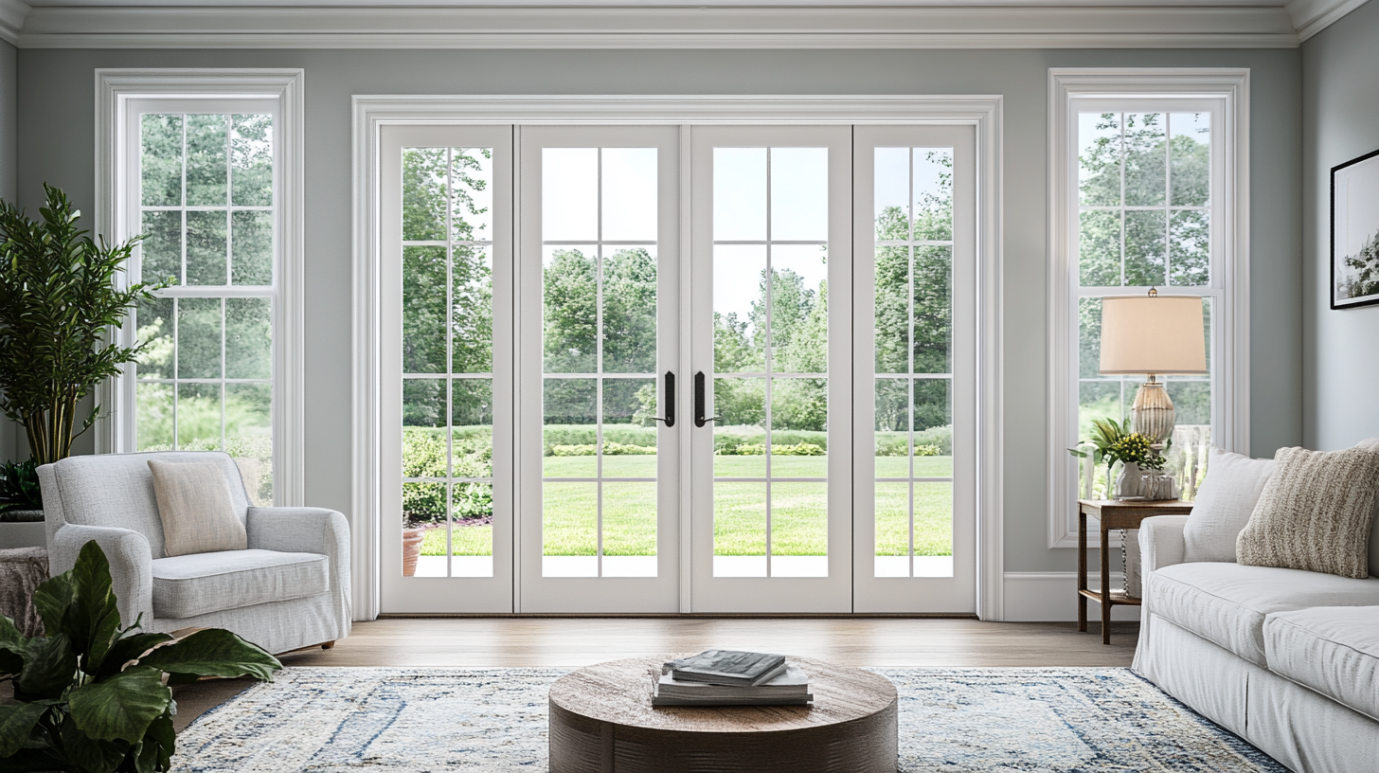Interior French Doors 101: Everything Designers Need to Know
- PA Home
Interior French doors bring a touch of elegance and French sophistication while effectively dividing spaces and enhancing natural light and openness. Whether in modern apartments, traditional homes, or commercial spaces, French doors seamlessly balance beauty with practicality, making them a focal point in any design. This article delves into the design styles, material options, installation tips, and more, providing designers and homeowners with the insights needed to make the best choices for their spaces.
What Are French Doors?
Originating in 17th-century France, French doors were originally used to connect indoor spaces to gardens, offering both beauty and excellent ventilation and light. French doors are characterized by their symmetrical, multi-pane design and expansive glass panels. Over time, the design of French doors evolved, becoming a key element in interior design. Today, French doors are not limited to traditional homes—they are also favored in modern homes and commercial spaces for their ability to create a sense of openness and to bring in natural light.

How French Doors Enhance Aesthetic Appeal and Practicality
At the heart of French doors is a balance between form and function. The classic double-panel design, with its detailed glass inserts, exudes sophistication while adapting seamlessly to various décor styles. Whether adorning a traditional living room with vintage hardware or enhancing a modern space with minimalistic frames, French doors add an inviting ambiance and a sense of openness. Imagine a sunlit room where the door’s clear, expansive glass creates an almost boundary-less flow between your interior and an enchanting outdoor patio.
French Door Design Styles and Ideal Applications
French Door Design Styles and Ideal Applications unlock a new level of elegance in any space. These doors serve as both functional gateways and striking design statements, seamlessly merging classic charm with modern innovation. Whether you’re aiming to add a vintage flair to a cozy living room or create a bold, contemporary ambiance in an urban loft, French doors offer versatile solutions that brighten interiors and invite nature inside.
Comparing Traditional and Modern Design Styles
Traditional French doors are often characterized by wooden frames and double doors with detailed glass panels. This design emphasizes craftsmanship and detail, making it ideal for classic, country, or European-style interiors. In contrast, modern French doors feature simpler frames with larger glass panes, aligning with the minimalist or industrial style of contemporary interiors. Designers can choose between these options based on the overall design of the space.
How to Choose the Right French Door Based on Interior Décor Style
Choosing the right French door depends on the overall interior décor. For example, modern minimalist spaces benefit from sleek aluminum French doors with clean lines and expansive glass panels. On the other hand, traditional wooden French doors are perfect for adding warmth and richness to a space, especially in classic or vintage-themed interiors.
Applications of French Doors in Different Rooms
- Living Room: French doors are often used to connect the living room to dining areas, balconies, or gardens, enhancing the room’s openness and allowing more light.
- Study: Glass-panel French doors offer the advantage of sound isolation while still letting in plenty of light, making them perfect for a study or home office.
- Bedroom: In bedrooms, frosted or decorative glass French doors provide privacy while maintaining the aesthetic appeal and spacious feel of the room.
What Are the Types of Interior French Doors?
French doors come in an array of styles that cater to every design need—from the classic charm of hinged doors to the sleek efficiency of sliding, pivot, and bi-fold options. Each type brings its own flair and functionality, effortlessly bridging indoor and outdoor spaces while enhancing light and style. Here are some of the most popular types of interior French doors:
1. Traditional Hinged French Doors(Swing French Doors)
Traditional hinged French doors exude timeless elegance with their classic two-panel design that swings open gracefully. These swing french doors are perfect for adding a vintage touch to your home, especially when paired with ornate hardware and rich wood finishes. Imagine them framing a picturesque view or leading to a lush garden, where their warm, intricate details complement a cozy, traditionally styled interior.
2. Sliding French Doors
Sliding French doors bring a modern, streamlined appeal to any space. Their smooth, track-guided movement creates a sleek profile that maximizes natural light and expands the visual boundaries of your room. Ideal for contemporary living areas or stylish patios, these doors often feature frameless or minimalistic designs that invite the outdoors in, crafting a seamless transition between interior and exterior environments.
3. Bi-Fold French Doors
Bi-fold French doors are designed to make a dramatic impact by folding in multiple panels to reveal a wide, open space. This design is especially popular in modern homes that celebrate open-plan living, as it effortlessly merges indoor and outdoor areas. The clean lines and contemporary hardware of bi-fold doors not only enhance the aesthetic appeal but also create a dynamic, inviting atmosphere for entertaining guests or enjoying a peaceful day indoors.
4. Pocket French Doors
A pocket French door slides into the wall, hidden from view when open. This style is excellent for areas where you want to maximize space without the door swinging out, often used in smaller rooms or areas with limited floor space.
5. Multi-Panel French Doors
Multi-panel French doors break away from the traditional dual-panel mold, offering a creative blend of several smaller glass sections that can be mixed and matched. This design provides endless possibilities for light play and privacy, making them a versatile choice for both room dividers and grand entrances. Whether you opt for clear, frosted, or textured glass, these doors allow you to experiment with patterns and hues, adding a layer of artistic flair to your interior design.
What Are the Materials of French Doors?
The material composition of interior French doors greatly affects their appearance, durability, maintenance needs, and cost. French doors typically consist of a frame and the glass panels, so when we talk about materials we are mostly referring to the frame (and sometimes the core). Here are the common materials used for interior French door frames and and their pros/cons for interior French doors:
| Material | Pros | Cons |
|---|---|---|
| Wood (Solid Lumber or Wood Veneer) | Classic, warm look; easy to customize size & style; good sound insulation. | Can warp or swell if not sealed; requires painting or refinishing over time; heavier than alternatives. |
| Engineered Wood/MDF | Affordable; smooth surface great for painting; resists warping; lighter weight. | Lacks natural wood grain character; not as high-end in look; can be less durable to impact. |
| Steel/Aluminum | Sleek modern aesthetic with slim profiles; extremely durable; low maintenance (powder-coated finishes). | Higher cost (especially for custom sizes); limited off-the-shelf availability in some areas; can appear cold or industrial-looking for traditional decor. |
| Fiberglass | Low maintenance; stable in humidity changes; can mimic wood texture; often pre-finished. | Fewer style options for interiors; generally used in exterior settings – limited need indoors; mid-to-high price range. |
| Vinyl (uPVC) | Very budget-friendly; never needs repainting; good for casual or utility spaces. | Thick frames reduce glass area; usually only comes in white or neutral; can look plasticky and may discolor over time. |
When choosing materials, consider the design style, budget, and practical needs of the space.
For example, in a high-end contemporary project, the client might prioritize the look of slim steel French doors despite the cost, whereas in a cost-conscious renovation, painted MDF French doors could achieve the desired look within budget.
Also, mixing materials is possible: e.g., wood French doors with metal grilles inside the glass for a decorative touch, or a steel door with wood cladding. However, those are specialized options. Most projects will involve a straightforward choice between a wood (or composite) French door vs. a metal one, with glass selection to suit privacy needs.
Customization and Sizing: Standard vs. Custom French Doors
One size does not fit all when it comes to interior doors, especially in older homes or unique architectural spaces. Fortunately, French doors are available in standard sizes to fit typical door openings, and they can also be fully customized for special requirements. Interior designers should be mindful of dimensions and proportions to ensure a perfect fit and aesthetic balance.
Standard Interior French Door Sizes
Many interior French doors come in a few standard dimensions that match common rough openings in homes. For a pair of French doors (double doors), the most common sizes are typically:
| Category | Dimension | Details |
|---|---|---|
| Door Height | 80 inches (6’8″) | Standard door height for most homes, fitting comfortably under 8-foot ceilings with a header and flooring. |
| Alternate Door Heights | 84″ and 96″ | Options available for homes with higher ceilings or for a more grand, dramatic effect. |
| Double French Doors | 48″, 60″, and 72″ | Total width for both doors. For example: a 48″ opening = two 24″ wide doors (ideal for closets or small passageways), a 60″ opening = two 30″ wide doors (one of the most common sizes) a 72″ opening = two 36″ wide doors (creates a bold statement in larger rooms). |
| Single French Door | 28″, 30″, 32″, or 36″ | Single-panel French doors are used in narrower openings; popular sizes like 32″ or 36″ are ideal for offices or patios where only one swinging panel is desired. |
Using standard sizes has the advantage of being readily available and cost-effective. You can often find stock interior French doors at home improvement stores in these standard dimensions, which means shorter lead times and lower cost than custom. Additionally, standard doors will fit standard rough openings (framed openings) without significant modifications.
Custom French Door Sizes
When standard sizes won’t work – perhaps the opening is non-standard, or the design calls for a dramatic oversized door – you can go custom. Custom-sized French doors are made-to-order to the exact dimensions and style specifications you require. This option provides maximum flexibility:
You can create taller doors, e.g., 8 feet or even 9-10 feet tall French doors for a grand foyer or high-ceiling room. Tall French doors can be stunning, adding to the verticality of a space (but ensure proper engineering – very tall doors may need a thicker frame or more hinges to stay true).
The obvious downside of custom French doors is cost and lead time. Custom fabrication can be significantly more expensive than standard doors – often several times the cost. As a ballpark, custom interior French doors (especially in specialty materials like steel or high-end wood with custom glass) could easily start in the low thousands of dollars for a set and go up from there. Also, expect a wait time of a few weeks to a few months for manufacturing and delivery, depending on complexity.
How Much Does Interior French Door Cost?
Budget is a practical aspect that even the most aesthetic-focused interior designer must consider. The cost of interior French doors can vary widely, depending on factors like material, size, customizations, hardware, and installation conditions.
A pair of standard-sized interior French doors (for example, a 60″x80″ set in pine or composite, prehung) can be relatively affordable, often ranging from $300 to $800 for basic models at big-box stores. If you opt for high-end solid wood (like mahogany) or premium factory finishes, that cost might go up to $1,000–$1,500 for the doors.
When you step into the custom French doors realm, costs increase: custom interior French doors can easily start around $2,000-$3,000 and go upwards(Especially for difficult designs).
According to a HomeGuide cost guide, interior French doors (standard) average $600–$3,000 installed, whereas custom French doors average $3,000–$15,000. That upper range would be for something like custom steel doors or very large bespoke units. So, there’s a French door option for almost every budget – it’s the difference between off-the-shelf vs. made-to-order.
The total cost of a door is not only the customization, but also the cost of doors, cost of hardware, cost of finishing, and cost of labor. A mid-range project might allocate, for example, $1200 for the doors, $200 for hardware, and $500 for install, totaling ~$1900. Align these numbers with the client’s overall budget and the priority level of the French doors in the project. Sometimes splurging on a stunning set of interior French doors as a focal point can elevate the whole project, and you can economize elsewhere.
Are Interior French Doors Worth the Value?
From a value perspective, interior French doors can enhance the perceived value of a property. They are often seen as a sign of a more upscale, thoughtfully designed home. While they may not add as much monetary value as an extra bathroom, they can attract buyers who appreciate design. For your clients, emphasize that French doors are a lasting upgrade. They are a timeless feature that won’t need replacing for style reasons. A quality French door will function well for decades. They can also improve space functionality, such as making a home office possible or increasing natural light.
How to Install French Doors?
Installing interior French doors is a task that intersects both design and engineering. As an interior designer, you might not be the one physically hanging the doors (contractors or carpenters do that), but understanding the installation process and challenges will help you make informed design decisions and guide the project smoothly. Below is the simple process:
- Install the door frame, making sure it is level and vertical.
- Attach the hinges to the door panels and door frame.
- Check the doors to ensure they open and close smoothly, and adjust as needed.
Installation Tips:
- 📏Double-Check Measurements:Measure twice, order once! Ensure all dimensions are accurate to avoid costly mistakes.
- 💬Communicate with the Contractor:Discuss design specifics like the placement of the active door and potential obstructions like thick rugs.
- 📑Provide Manufacturer’s Installation Guide:For custom features like integrated blinds or special locks, ensure the installer has the manufacturer’s guide in advance.
Choose PA For Your Design Projects
When it comes to high-quality, custom interior French doors, PA Window is one of China’s top 10 door manufacturers. With expertise in delivering tailored solutions for large-scale projects, PA Window can help bring your design vision to life.
Ready to elevate your design projects with interior French doors? Download our French Door Style Guide for Designers, packed with design ideas, technical tips, and style pairings to inspire your next project. Or, if you’re looking for a more personalized touch, schedule a design consultation with our team to explore custom interior French door solutions tailored to your needs.
Contact PA today and let us help you create the perfect interior france doors for your design projetcs.
FAQs about French Door
What are the benefits of interior French doors with glass?
Are France garage doors energy efficient?
How much is a patio French door exterior with sidelights?
Which is better, sliding or French doors?
What is double vs French doors?
How much is a 4-panel patio French door exterior?



